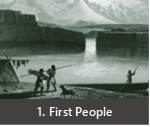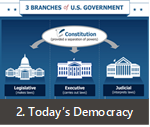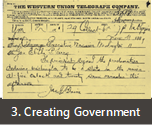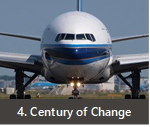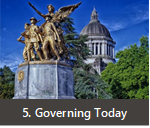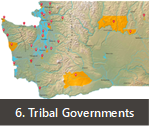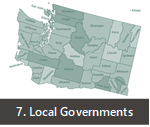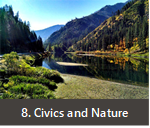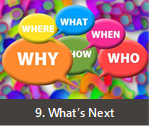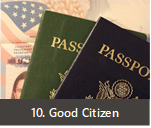The State We're In: Washington - Teacher Guide Ch. 3: Creating Washington's Government
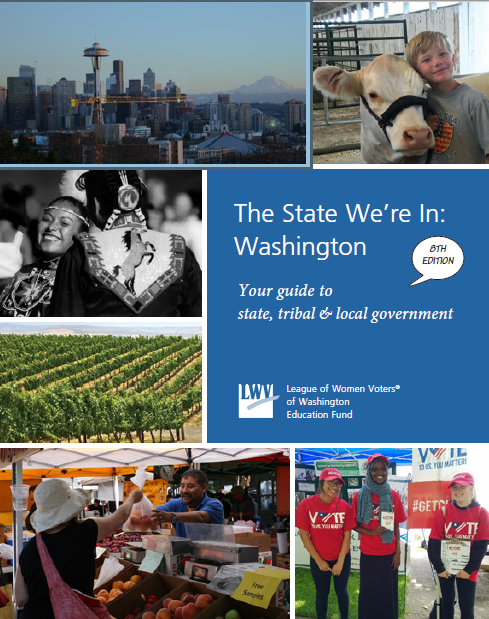
Book cover
Chapter 3 The State We’re In:
Washington
Creating Washington's Government
Access the whole book: The State We're In Washington
Enduring Understanding
Washington’s journey to statehood is a complex cultural, economical, political, environmental, and ecological story and its impact is still felt today
Supporting Questions
Students consider these questions - finding and using evidence to support the Enduring Understanding.
- How did pioneers impact our state?
- How are the Washington state constitution and the U.S. Constitution similar and different?
- What role did the railroad play in the formation of Washington as a state?
- Why were tidelands a debated issue in the journey to statehood?
- Why is education a “paramount duty” in our state?
- Why might our state have an Equal Rights Amendment?
Learning Targets
Students will be able to…
- Explain the impact pioneers had on native populations in our state.
- Compare the Washington State and U.S. Constitution to point out specific similarities and differences
- Explain the economic, political, and environmental impacts of the railroad on our state.
- Explain the cultural, political, and economic reasons for the protection of tidelands.
- Explain the role of education in our state.
- Explain why our state has an Equal Rights Amendment and how that impacts our citizens.
Launch
Hook students into the content of Chapter 3 of The State We're In Washington
Distribute the Student Handout: Launch to students.
- Teachers may choose to project the pictures to make small details easier to see. .
- There is no “correct” answer. Encourage the students to explain their answer.
- If students cannot come to a consensus have the group explain why.
- For an extension activity, have students write a claim, evidence, reason paragraph about which picture they think does not belong and why
Resources
Focused Notes
Activating student thinking about the content of the entire chapter.
- Distribute the Student Handout: Focused Notes to students.
- As students read they will record their understanding, thinking, and questions about the content using the handout. This can be done individually or collaboratively in pairs or small groups.
Resources
Text-Dependent Questions
Engaging students in a close reading activity about specific content in the chapter.
Distribute the Student Handout: Text-Dependent Questions document to students.
First Read
Have the students read the section and answer the First read questions on the Text Dependent Questions document.
Second Read
Use the Second read questions below to facilitate a small or whole group discussion about the reading section. When they are done have them use the Text Dependent Questions handout to record their notes.
- How is a territory different than a state?
- What is the symbol that is used to depict mountains on the map?
- How are reservations shown on the map?
- Why do you think that the map maker included more than just Washington on the map?
- Look up the names of the tribes in your region. Are they labeled on the map? Is there name spelled the same? What is the reason for your answers.
- Read the “Note” on the map. Why do you think this was included on the map?
Post read
After students have done a first and second read of the page, use the following questions to facilitate a class discussion. Have students address:
- Why do you think that the map maker included notes about the abundance of trees but does not include images or symbols of them on the map?
- Use the following link to map titled, Indian reservations, allotments and ceded areas in Washington, created in 1961. What do you notice about this map compared to the one in the text? Why do you think the Native American reservations were placed where they were?
- Based on the information from the map, what kind of people were sought out to be in Washington? Use evidence from the map and the notes to support your answer.
Notes: You may want to use some or all the Second read or Post read questions. The purpose of the Text Dependent Question activity is to have students do multiple close reads of the text leading to discussion that engages all students. Therefore, you may need to add reading strategies that meet the needs of your students.
Resources
Focused Inquiry
A focused inquiry is a one to two day lesson that will have students engaging in the C3 Framework’s Inquiry Arc.
In this focused inquiry, students investigate the question How does bias shape our understanding of a historical event? Students engage in deep reading of primary and secondary sources, analyzing the different perspectives of the execution of Chief Leschi. After small and large group discussions, students will develop an argument answering the compelling question using evidence about the execution of Chief Leschi from the sources.Standards
- SSS1.6-8.1 Analyze positions and evidence supporting an issue or an event.
- SSS2.6-8.2 Evaluate the breadth, reliability, and credibility of primary and secondary sources to determine the need for new or additional information when researching an issue or event.
- SSS3.6-8.1 Engage in discussion, analyzing multiple viewpoints on public issues
- C2.6-8.2 Distinguish the structure, organization, powers, and limits of government at the local, state, and tribal levels
Learning Goals
- Students will cite and use evidence from a source to support a claim.
- Students will determine the perspective as well as the values and limitations of primary and secondary sources.
- Students will engage in small and large group discussions to share multiple viewpoints.
- Students will create a written response to the compelling question How does bias shape our understanding of a historical event?
Compelling Question
How does bias shape our understanding of historical events?
Staging the Question
- As a class, have the students brainstorm bias that they think that people have about middle school students. Have them think of why people may have bias.
- The teacher may wish to share what are things about their life that may shape their bias (i.e. where they grew up, where they went to school, how old they are. etc.)
- Have the students watch THE LAB: A portrait session with a twist (3:16). While the students watch them have them take notes on how what the photographer was told about the man changed the way they interacted with him and how the photo looked.
- When they are done, have
the students discuss with a partner “how does bias shape our understanding of
historical events?” After their discussion have students write their thoughts
on a scratch paper.
Formative Performance Task:
- Use the Student Handout: Analysis Organizer to hold thinking about three sources.
- Answer the supporting question: “What is the story of Chief Leschi’s execution?”
Notes:
There may be a need to activate and build general background knowledge before having students engage with the sources in Appendix B.
Page 40 of Chapter 3 of The State We’re In: Washington has a page about Chief Leschi but it is best read after engaging with this focused inquiry as it may rob students of the opportunity to think about the compelling question without prejudice.
The sources present views that may be hurtful and/or offensive so it is important to be able to address this depending on the nature of the environment and culture of the classroom.
Featured Source in the Analysis Organizer
- "Execution of Leschi" Pioneer and Democrat, 2/26/1858, Page 2, Column 1
- “Leshi, Last Chief of the Nisqually” The Indian War section only
- “Historic Nisqually chief exonerated” Seattle Times 2004
Argument
After students analyze various sources to answer the supporting question and discuss their thinking with the class, they will write a brief response to the compelling question: How does bias shape our understanding of historical events? Responses should include a claim, evidence, and reasoning and cite specific information from sources.
Taking Informed Action
Engage students in a whole class discussion about the different strategies that they engaged in with each of the documents to detect bias. Have the students create an anchor chart that has questions and reading strategies to help then look at sources with scepticism. Have students apply questions and strategies using a current news article. Resources
Resources
Teacher's Guide Menu
Download the all the guides in one document or click on an individual chapter below.
